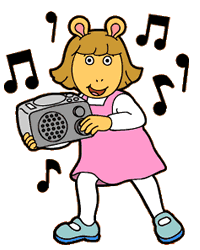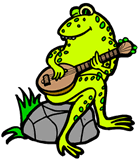Move to the Music with Arthur
 Based on Activity Lesson "Moving to Music" from Arthur's Music Jamboree Based on Activity Lesson "Moving to Music" from Arthur's Music Jamboree
Dancing is a fun and exciting way to create musical expression. Musical movement can also help with coordination, language meaning, body awareness, and cognitive development. When following an instructional dance or movement to song, children can also learn self-control and cooperation.
Try these activities to experiment with different kinds of musical movement:
Musical Statues
Making "Musical Statues" challenges children to practice controlling their bodies. It also helps improve physical coordination and listening skills.
Materials
. Recorded music selections, some with a fast beat and others with a slow beat
Instructions
1. Play some music for children (varying slow and fast music) and encourage them to dance the way the music moves them. Explain that when the music stops they have to freeze in place, so they will have to listen carefully. While children are frozen in their "Musical Statues," you can point out some of the interesting poses they strike. If children are having trouble stopping on cue, you can encourage greater body control by slowing down the pace of the music.
2. Play some fast-tempo music, such as rock and roll or disco, and allow children to move around more freely. You may want to show them how to do some basic dance moves, such as "The Swim" (moving arms as if swimming) or "The Bug" (lying on your back and moving your arms and legs in the air).
Animal Hokey Pokey
 Children will practice identifying body parts and get their parts moving by doing this dance. Children will practice identifying body parts and get their parts moving by doing this dance.
1. Do "The Hokey Pokey" song and dance. After a round of the old standard, try the "Animal Hokey Pokey." Each child selects an animal and thinks of a body part to put into the circle.
2. Ask each child what animal and body part he or she selected.
3. Call a different child's name for each verse, and ask the child to respond by saying what animal he or she has chosen. Then sing the verse, pausing for the child to add in the animal's body part.
For example,
Group: "You put your..." [pause for child]
Child: "frog leg"
Group: "...in, you put your frog leg out..."
Other examples include: a bunny tail, a giraffe neck, a snake tongue, a dolphin fin, and so on. Encourage children to move their bodies in the same way the animal does.
There are dozens more musical activities and games with Arthur. !Tambien, hay actividades en espanol! Click Here!
|